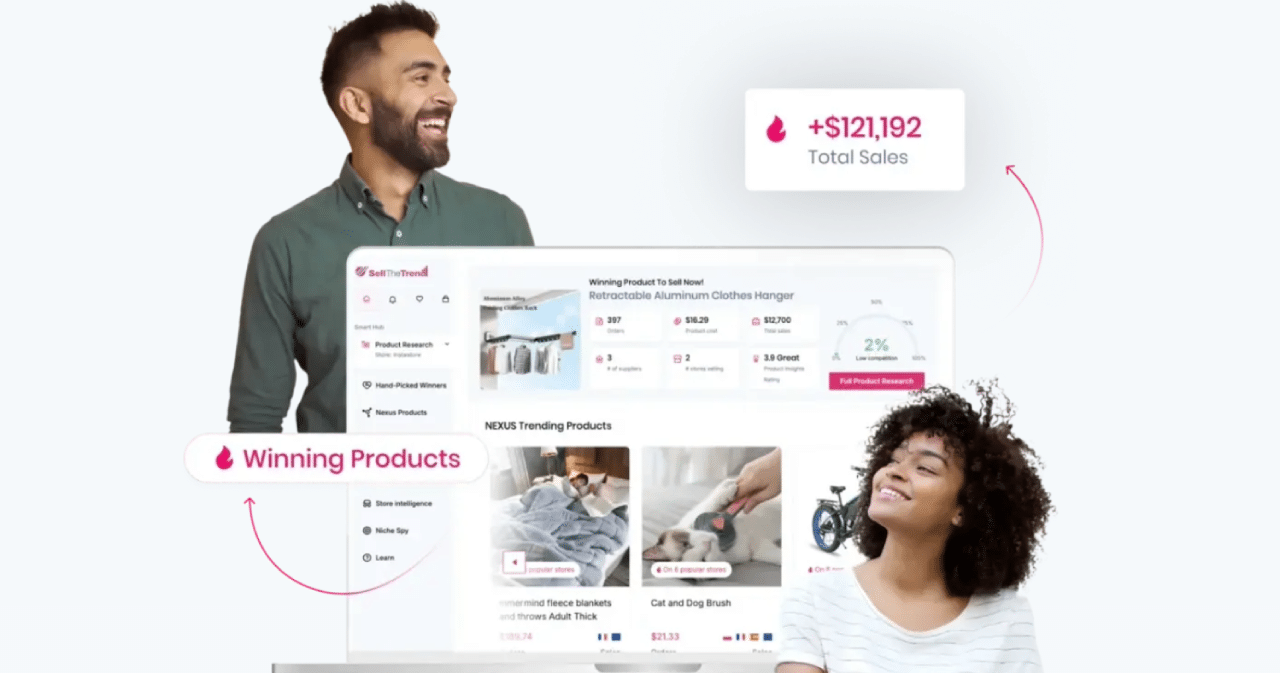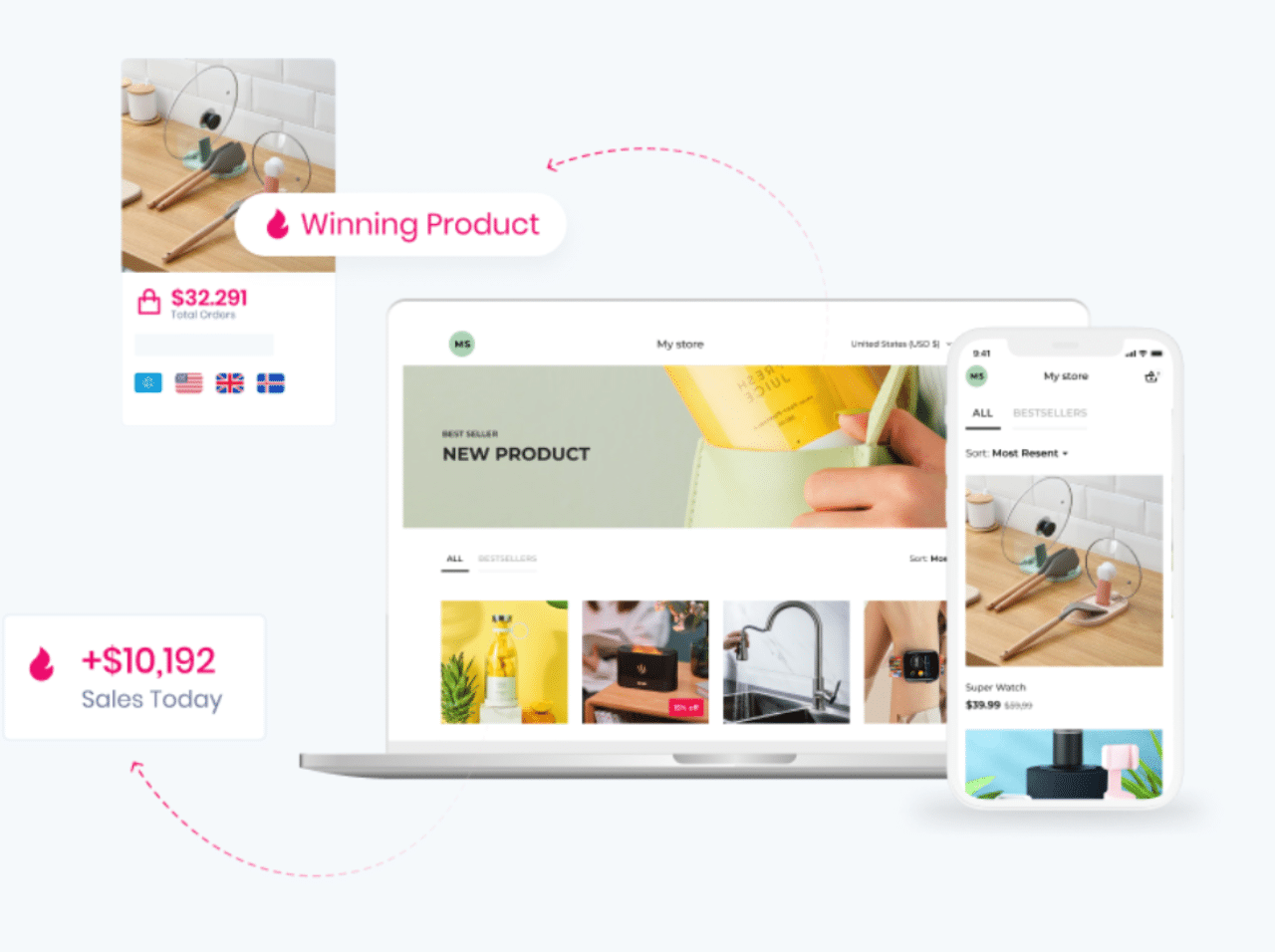Exploring Temu Competitors: The Top Alternatives For Dropshipping Success
Contents

Finding winning products is great…until everyone is selling the same items from the same supplier. That is the hidden challenge entrepreneurs face when relying on Temu alone.
So, how do we fix this?
With this article, you can explore the top Temu alternatives for dropshipping. Then, we will dive into how you can choose the best alternatives for your brand. You can also find 3 smart ways to grow your dropshipping business with confidence.
By the end of your read, you can have a clear plan to get your online store to stand out, find winning products, speed up fulfillment, and deliver a better customer experience.
Beyond Temu: Why Dropshippers Should Explore Other Options
Temu may seem like a great place to find cheap products, but Temu dropshipping does not exist (officially speaking). The platform simply is not designed to support the tools, features, or flexibility that dropshippers need to run and grow a real business.
This becomes a problem when you consider that dropshipping is not just a sourcing method; it is a full revenue model of eCommerce. To succeed, you need more than low prices from Chinese suppliers.
So while Temu offers numerous features, what moves the needle is having full control over your brand, a fulfillment setup you can trust, and systems that support long-term, scalable growth.
Here’s what real alternatives give you that Temu cannot:
I. Stand Out With Custom Content That Reflects Your Brand
Temu gives you a product page that looks the same as everyone else’s.
But with the alternatives? You get the freedom to write product descriptions and ad copy that sound like you. That means every word reflects your brand identity, not just the supplier’s catalog.
You can build real trust, show personality, and position yourself as more than just another store. Plus, you can maximize your marketing budget by creating useful content that builds brand authority and works across multiple channels, so you spend less on new assets and get more value from every message.
II. Ship Smarter With Warehouses Closer To Home
Temu relies heavily on Chinese manufacturers, which often prompts long shipping times and unpredictable shipping costs. Now, that might work for one-off sales, but not for stores focused on building loyalty and repeat purchases.
Smarter dropshipping platforms let you tap into local warehouses so you can ship faster and spend less. Here’s what that unlocks:
- Less risk tied to overseas delays
- A stronger brand reputation built on reliability
- Speedy order fulfillment that boosts customer satisfaction
III. Access A Vast Range Of Dropshipping-Ready Products
Temu gives you volume, not vision. You scroll through endless listings without knowing what sells.
Meanwhile, real dropshipping platforms offer an extensive product range built for growth. Plus, you get tools that can highlight trending products backed by real-time data. That means you can spot market shifts before your competitors catch on.
With access to data-driven tools, you can turn your dropshipping journey from random browsing into smart sourcing.
Level Up Your Store: 5 Temu Alternatives Built For Growth
Dive into the best Temu alternatives, look for a feature that solves your current bottleneck, and highlight it for a quick win this week.
1. Sell The Trend
 Sell The Trend brings serious power to your dropshipping business. How?
Sell The Trend brings serious power to your dropshipping business. How?
With advanced AI and seamless automation tools, it takes the guesswork out of product research, store setup, and fulfillment so you can move faster and grow smarter.
In addition, the platform’s Nexus AI scans 26 data points for every product to give you early access to trending items before they hit the mainstream. That kind of insight gives you a significant advantage. With this, you can lead the way with confidence and quality assurance built into every step.
The result? Well, they speak for themselves.
Sellers like Kyle Brattan have cleared $100K in sales. Yash Shah’s store is on track to hit $40K per month. Nelson Muriuki sees consistent five-figure revenue, all using Sell The Trend’s smart dropshipping tools.
Here’s what you will love most:
1.1. Smart Product Discovery
- Get real-time insights on trending products
- Access a vast array of 7 million products in 83 niches
- Spot hidden gems faster with AI-driven product research

1.2. Verified, Ranked Suppliers
- Use built-in tools to find the best competitive pricing
- Compare delivery times, product quality, ratings, and service reliability
- Choose from multiple suppliers (around 1,200), including US-based options

1.3. Full Automation That Works
- Product import feature with 1 click
- Launch high-converting product pages instantly
- Handle order fulfillment with tracking and customer updates
- AI-powered store builder that launches a ready-made, niche-focused store with free hosting and SSL in seconds

1.4. Pricing
- Lite: $29.97/month
- Essential: $49.97/month
- Pro: $99.97/month
- Pro+: $299.97/month
2. AliExpress DS

AliExpress DS connects you with products primarily manufactured in China and offers flexibility, whether you are making bulk purchases or ordering just one item to test.
But is it the right fit if fast delivery is your top priority?
The platform is ideal for dropshippers who care more about product variety and cost than speed. You will often deal with shipping delays, and quality variability across suppliers is something to watch.
Still, for store owners who want low-risk testing options and access to anything from trendy fashion to pet supplies, it is a go-to starting point.
2.1. Key Advantages
- Bulk discount options on high-volume orders
- Global shipping coverage to virtually any country worldwide
- Frequent promotional deals and coupons to reduce upfront costs
- Search by image feature to quickly find matching or similar products
- Integration capabilities with automation tools like AutoDS and DSers
- Massive product selection across every imaginable category and niche
2.2. Pricing
You can sign up and browse products for free. You only pay for the items you order.
3. CJDropshipping

With warehouses in the US, China, Germany, Thailand, and Indonesia, CJ Dropshipping supports faster regional shipping and reliable fulfillment.
What else sets it apart?
For sellers looking to launch unique dropshipping products, CJ includes print-on-demand and original design manufacturing (ODM) options. You can also add custom packaging and brand packaging to your orders, which makes your store feel more professional and brand-ready, something most platforms do not offer out of the box.
3.1. Key Advantages
- Quality inspection for each package
- Automatic order fulfillment and processing
- Partnerships with multiple shipping carriers
- Global warehouse network for fast, region-based fulfillment
- Professional product photography and video creation services
- 24/7 customer support and full-service product sourcing assistance from a dedicated personal agent
3.2. Pricing
CJ Dropshipping is free to use for listing products and syncing orders. You only pay for what you buy, like products, shipping, or extras like custom packaging.
From Options To Action: How To Pick What Works For You
Scan the list below, make a quick checklist of must-haves, and pick the platform that helps you protect and grow your store’s reputation long term.
Step 1: Your Goals, Your Rules. Let Them Guide Your Decision
Choosing a platform without clear goals is like hiring a team without knowing what job they are doing.
On the other hand, when you know exactly what you want from your dropshipping business, like reliable shipping, solid quality control, or better customer service, you stop chasing features and start picking tools that work for you, not against you.
What To Do
List your top priorities. What matters most to your store? Is it:
- Fast delivery
- Fewer refunds
- A strong brand
Then, think like your customer. What will they care about most: speed, quality, or support? Your answer helps shape your expectations.
Next, match each priority to a platform feature:
- Need reliable shipping? You will want local warehouses.
- Want quality control? Look for supplier vetting or inspection options.
Choose one focus area to improve first. Start with the areas that will impact your business or customer experience the most.
For example, let’s say you are in the medical space, and this time, you want to sell supplements like these from Brain Ritual. Your top priority should be reliable shipping because customers rely on timely relief.
So, prioritize platforms with local warehouses and real-time tracking to avoid delays. Next, layer in quality control by choosing a great supplier with inspection processes in place. Fixing delivery delays first can quickly reduce complaints and help you build a strong reputation as a supplement dropshipper.
Lastly, use the SMART framework to smooth out your goal. Going back to our example, your goal can be:

Step 2: Create Your Non-Negotiables Checklist
Every dropshipping platform promises the world, but not all of them give you what your business needs.
That is why you need to build a non-negotiables checklist to filter out platforms that look good on paper but will not deliver where it counts. Whether you are selling affordable clothing or beauty products, clarity keeps you from wasting time on trial-and-error.
What To Do
Look at negative reviews or past customer complaints. For example, if you continuously deal with inconsistent product quality or complicated return processes, flag those issues. Use them to set must-have features like supplier vetting or easy return tools.
You should also break down your workflow. Walk through a typical order from sale to delivery. Then, mark every step that needs platform support, like syncing stock or sending tracking updates.
In addition, talk to your team and ask what slows them down. Use their insights to highlight which features save the most time.
Finally, turn each insight into a requirement and create a checklist like this:

Step 3: Line Them Up: Which Platform Wins Where?
Once you know what you need, it is time to stack your options side by side to cut through the noise.
For example, one might lead in faster shipping, while another nails inventory management or supports multiple supplier relationships better. When you line them up, you see where each shines and where it falls short. So you get to choose based on strengths, not promises.
What To Do
Build a comparison grid with columns for attributes like faster shipping, quality checks, and product range. Mark who delivers what with check marks or color codes.
Then, score each one from 1 to 5 on how well it delivers on your needs (1 being the weakest, 5 being the strongest). Use real platform data like shipping speed estimates, integrations, or supplier variety.

Make sure to also weigh trade-offs completely. One platform may excel in supplier variety but fall short in shipping times. Highlight these gaps so you decide what to compromise on (if anything).
In addition, review how they scale. Some platforms handle small stores well but break down as order volume grows. So look for automation, multiple supplier relationships, and system stability.
You should also tie them back to your business process.
Ask: “Which one fits how I already work—or makes it easier?” Choose the platform that reduces friction, not one that adds more tools to juggle.
Now, comparing multiple platforms and combing through features can be time-consuming. Team up with a virtual assistant who can handle the research, listing, and comparisons for you. They can give you a clear shortlist of recommendations tailored to your needs, which helps you make faster, smarter decisions without getting lost in the details.
Step 4: Put It to the Test: How Does It Work?
A platform can look perfect on paper, but how it feels to use is what makes or breaks the experience. With this step, you can see how well the platform holds up when real work begins, not just how it looks on the homepage.
Use this as your chance to spot deal breakers before they drain your time or budget.
What To Do
- Sign up for a free trial. Test how fast you can search for products, reach official dropshipping support, or explore the key features.
- Evaluate dashboards and settings. Can you find what matters most without getting lost?
- Place a mock order. Watch for delays, unclear steps, or issues connecting with your right supplier.
- Import a product to your store. See if the product page is editable, high quality, and formatted cleanly. Check the tools for tweaking titles, images, and pricing.
- Message customer support. Ask about minimum order quantities or favorable pricing on a niche item. Judge how quickly and clearly they respond.
Dropship Like A Pro: 3 Practices That Separate Winners From Strugglers

Running a dropship business requires more than just high-quality products. Scan these best practices to fix what is slowing you down and level up how you run things day to day.
A. Automate Customer Communication
When you run a dropship business, you do not control inventory or shipping, so communication becomes your safety net. Customers do not want silence. They want:
- Quick updates
- Clear answers
- Timely support
Automate these touchpoints to build trust without adding more to your daily to-do list. For impulse buyers, this is where you either lock in the sale or lose it. A quick confirmation or update right after checkout reassures them they made the right move.
Here’s what you need to do:
- Set up FAQs and chatbot responses to automate common questions like return policies or shipping timelines.
- Follow up with delivery confirmations. Let customers know their order arrived to reduce “Where’s my order?” messages.
- Use mass notification tools to broadcast time-sensitive offers or storewide updates.
- Send order confirmations automatically. Set up email triggers so buyers know their order went through.
- Include tracking updates with every shipment. Use tools that sync shipping info and send updates without you lifting a finger.
B. Build A Branded Shopping Experience, Not Just A Storefront
A dropshipping site without branding feels like a random marketplace. But a branded shopping experience builds trust, sets you apart, and makes your store feel like THE place to buy.
This matters even more when attracting style-conscious shoppers who judge your credibility at a glance. For example, if you sell minimalist home goods, your site should feel clean and curated, not cluttered like a discount warehouse.
Here’s what you need to do:
- Use consistent fonts and icon styles across your store.
- Add lifestyle photos that match your customer’s aesthetic.
- Streamline your navigation so the vibe feels premium, not chaotic.
- Write unique product descriptions in a voice that matches your brand tone.
- Choose a color palette that reflects your niche. For example, earth tones for wellness, bold contrast for tech.
To skip the trial and error, get a web design agency to help you build a site that feels intentional. They can align your visuals, layout, and messaging so your site works as hard as your products.
C. Think Beyond Your First 100 Orders
Planning for growth is not just about getting more orders; it is about handling more without chaos. If your systems crack under pressure or rely too much on manual fulfillment, your business will not scale smoothly.
So think ahead so every new customer adds profit, not stress, with every product sold.
Here’s what you need to do:
- Align with suppliers on stock levels, restocks, and order volume.
- Pick a flexible platform with direct integrations that scale with you.
- Build a backup plan with alternate suppliers for flash sales or delays.
- Set long-term sales goals to time expansions and plan tool upgrades.
- Prep your finances early. For example, start looking into MACRS cost segregation services if you plan to invest in a showroom or office.
Conclusion
Choosing from Temu alternatives for dropshipping goes beyond just picking a new platform. It is about solving your store’s biggest pain points.
Look at your data: Do you need better shipping? Clearer branding? More supplier options? Focus on what’s slowing you down most.
Then, create a shortlist, test each one, and see what clicks. Do not wait until peak season to find out what does not work.
Want to start today?
Test Sell The Trend. With AI-powered tools, you can remove the frictions of dropshipping and start selling with ease. Register now to start your free trial.
Author Bio:
Burkhard Berger is the founder of Novum™. He helps innovative B2B companies implement modern SEO strategies to scale their organic traffic to 1,000,000+ visitors per month. Curious about what your true traffic potential is?
- Author picture: Here
- Gravatar: [email protected]








